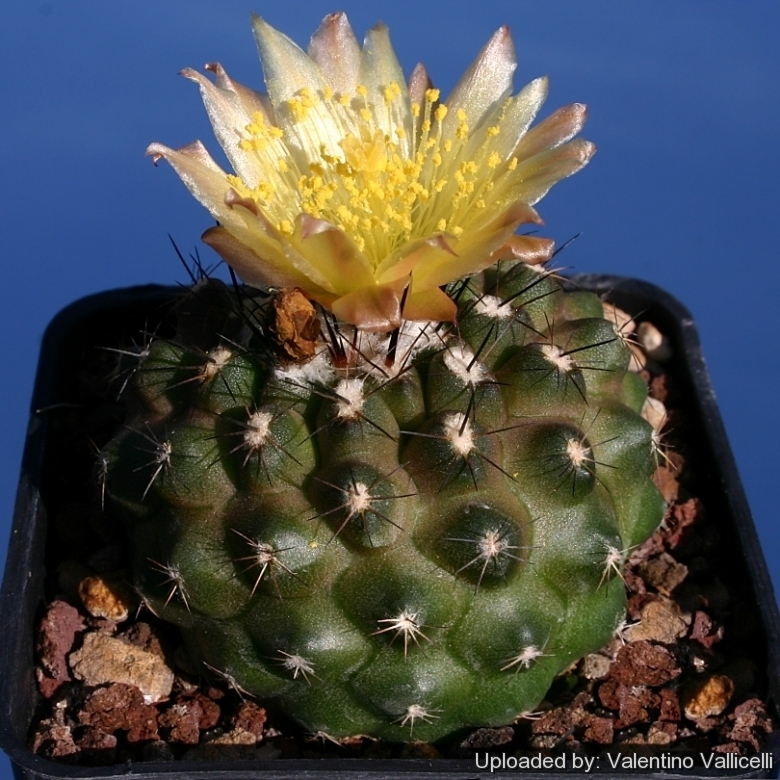
Copiapoa humilis Photo by: Valentino Vallicelli
Origin and Habitat: north of Paposo, towards Blanco Encalada south along the coast to Barquito just south of Chanaral (in the regions of Atacama and Antofagasta) Chile. Copiapoa humilis has a relatively wide range , but it is severely fragmented (extent of occurrence 24,000 km2).
Type locality: Paposo, Antofagasta, Chile.
Altitude: 0-1200 m above sea level.
Habitat: It grows in patches and in crevices in the coastal deserts on the steep mountain base among fragmented stones. The long tuberous root of this copiapoa is buried deeply in these soils which are very poor in organic matter. In the area where this plants grow there is very little rain but frequent coastal fog, which provides a significant part of their water needs. The common presence in habitat of plants with juvenile spination forms on old taproots is due to the frequent grazing damage inflicted by donkeys. Overall the population seems to be stable, the major threats are mining activity within its area of distribution, illegal collection, and to a lesser extent road construction. Goat grazing used to be a threat but this activity is decreasing in the area. The population south of Copiapó is affected by drought.
Synonyms:
See all synonyms of Copiapoa humilis
Common Names include:
SPANISH (Español): Humildito
SWEDISH (Svenska): Liten randkaktus
Description: Copiapoa humilisSN|9790]]SN|9790]] is a very small, low growing cactus with roots like turnips, sometime solitary but usually clumping at the base. It's a highly variable taxon with several more or less similar forms that could be described as local varieties. Taylor suggests that this is a very complex species or species aggregate, perhaps representing geographical varieties or, in some cases, critical species, listed here in sequence from north to south: Copiapoa tocopillanaSN|9790]]SN|1326]], Copiapoa tenuissimaSN|9783]]SN|1138]], Copiapoa variispinataSN|9770]]SN|9776]], Copiapoa paposoensisSN|1425]]SN|9794]], Copiapoa taltalensisSN|1391]]SN|1391]], Copiapoa longispinaSN|9794]]SN|1425]] and possibly Copiapoa chaniaralensisSN|9776]]SN|9770]] and Copiapoa esmeraldanaSN|1138]]SN|9783]]. In considering Copiapoa humilisSN|1326]]SN|9790]] species, we need to bear in mind the remarkable differences between young plants, with short, thin spination and the darker coloration of the body compared to the more robust adults with longer and sturdy, flexible spines.
Stem: Subglobular, depressed, somewhat soft, producing copious wool in the apex. 2,5-9 cm broad by 2-6 cm high pale olive-green to tan. Juvenile stems are darker purple-red to almost black.
Ribs: About 8-14 slightly spiralling forming distinct elevated tubercles.
Areoles: Well separated, with white wool.
Root: Large tap-root, connected to the stem by long slender neck. Seedlings naturally produce the huge tap root, starting from germination, i.e. before the plant stem becomes mature.
Spines: 10-14 greyish-white to yellowish (in youth) to black (adults).
Radial spines: About 7-13, thin, needle-like, setaceous, open wide on sides, marginal, somewhat bent, 2-25 mm long.
Central spine: 1 to 4, sometime absent on juvenile specimen, fairly slender, erect, straight or curved 10-35 mm long.
Flowers: At the apex, 2-4 cm long, corolla sulphur yellow, strongly scented. In cultivation Copiapoa humilisSN|9790]]SN|9790]] are able to flower from immature stems at an early age (about 2 years from germination) and set viable seed. Ovary always glabrous, with smaller scales inserted only above the peripheral ring.
Fruits: Round, naked, bright red, up to 8 mm long.
Seeds: Black.
Subspecies, varieties, forms and cultivars of plants belonging to the Copiapoa humilis group
Bibliography: Major references and further lectures
1) Guerrero, P., Walter, H.E., Faundez, L. & Saldivia, P. 2013. Copiapoa humilis. In: IUCN 2013. IUCN Red List of Threatened Species. Version 2013.2. <www.iucnredlist.org>. Downloaded on 06 March 2014.
2) Edward Anderson “The Cactus family” Timber Press, Incorporated, 2001
3) James Cullen, Sabina G. Knees, H. Suzanne Cubey "The European Garden Flora Flowering Plants: A Manual for the Identification of Plants Cultivated in Europe, Both Out-of-Doors and Under Glass" Cambridge University Press, 11/Aug/2011
4) David R Hunt; Nigel P Taylor; Graham Charles; International Cactaceae Systematics Group. "The New Cactus Lexicon" dh books, 2006
5) Urs Eggli, Leonard E. Newton: “Etymological Dictionary of Succulent Plant Names.” Birkhäuser 2004
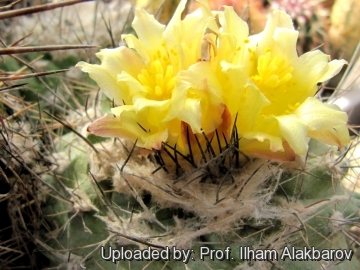 Copiapoa humilis Photo by: Prof. Ilham Alakbarov
Copiapoa humilis Photo by: Prof. Ilham Alakbarov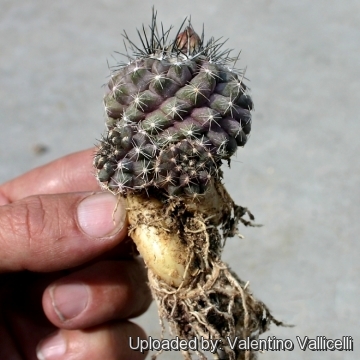 Copiapoa humilis Photo by: Valentino Vallicelli
Copiapoa humilis Photo by: Valentino Vallicelli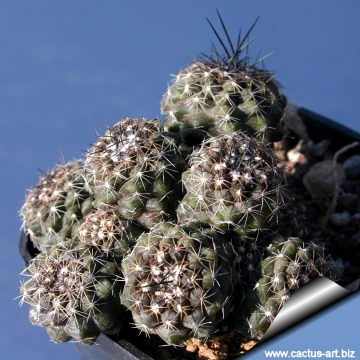 Copiapoa humilis Photo by: Cactus Art
Copiapoa humilis Photo by: Cactus Art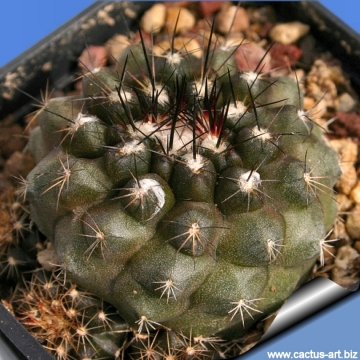 Copiapoa humilis Photo by: Cactus Art
Copiapoa humilis Photo by: Cactus Art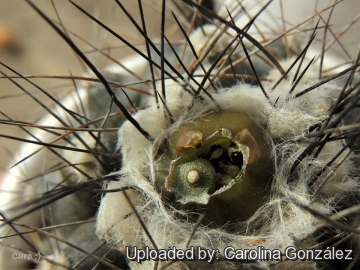 Copiapoa humilis Photo by: Carolina González
Copiapoa humilis Photo by: Carolina González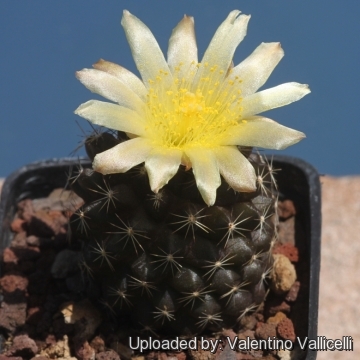 PM200 (Collector: Ken Preston-Mafham) Paposo, Antofagasta, Chile Photo by: Valentino Vallicelli
PM200 (Collector: Ken Preston-Mafham) Paposo, Antofagasta, Chile Photo by: Valentino Vallicelli Copiapoa humilis Photo by: Cactus Art
Copiapoa humilis Photo by: Cactus ArtSend a photo of this plant.The gallery now contains thousands of pictures, however it is possible to do even more. We are, of course, seeking photos of species not yet shown in the gallery but not only that, we are also looking for better pictures than those already present.
Read More... Cultivation and Propagation: Considering that Copiapoa humilisSN|9790]]SN|9790]] comes from a habitat with an extremely arid climate, they are remarkably tolerant of pot culture. These plants have thick taproots and are susceptible to overwatering. They requires also an appropriate air circulation. Copiapoas are summer grower species easy to cultivate
Growth rate: It is a relatively rapidly growing and easily flowering species that will make clumps given the best conditions.
Soils: It likes very coarse mineral cactus mix soil, but can become too elongated if compost is too rich.
Repotting: Use pot with good drainage.
Watering: Water moderately from Spring to Autumn, but do not overwater (Rot prone), it must be strictly kept dry throughout the winter quiescent period since it is very sensitive to any moisture excesses keep dry in winter.
Fertilization: Feed with a high potassium fertilizer in summer.
Hardiness: They need to be kept in a cool place during winter rest and are resistant to light frost if kept on the dry side prior to, and during, cold weather ( they are hardy to -4 C ° C short periods). However some warmth throughout the year will increase the grower's success (minimum 5° to 8°C during rest season).
Exposition: Requires full sun or light shade and careful watering to keep plant compact with strong coloured spines. Tends to bronze in strong light, which encourages flowering and heavy spine production. Light shadow my be useful in the hottest summer days.
Uses: It is an excellent plant for container growing. It always looks good and stays small. It look fine in a cold greenhouse and frame or outdoor in a rockery.
Pests & diseases: It may be attractive to a variety of insects, but plants in good condition should be nearly pest-free, particularly if they are grown in a mineral potting-mix, with good exposure and ventilation. Nonetheless, there are several pests to watch for:
- Red spiders: Red spiders may be effectively rubbed up by watering the infested plants from above.
- Mealy bugs: Mealy bugs occasionally develop aerial into the new growth among the wool with disfiguring results, but the worst types develop underground on the roots and are invisible except by their effects.
- Sciara Flies: Sciara flies are one of the major problems for seedlings. It is a good practice to mulch your seedlings with a layer of grit, which will strongly discourage the flies.
- Scales: Scales are rarely a problem. It is wise to treat your whole collection with a systemic insecticide twice a year in spring and autumn.
- Rot: Rot is only a minor problem with cacti if the plants are watered and “aired” correctly. If they are not, fungicides won't help all that much. To prevent rottenness it is also advisable to surround its root neck by very rough sand or grit, this help a fast water drainage.
Propagation: Seed, cutting, grafting. Seeds germinate in 7-14 days at 21-27° C in spring, remove gradually the glass cover as soon the plants will be well rooted (ca 1-2 weeks) and keep ventilated, no full sun for young plants!

















